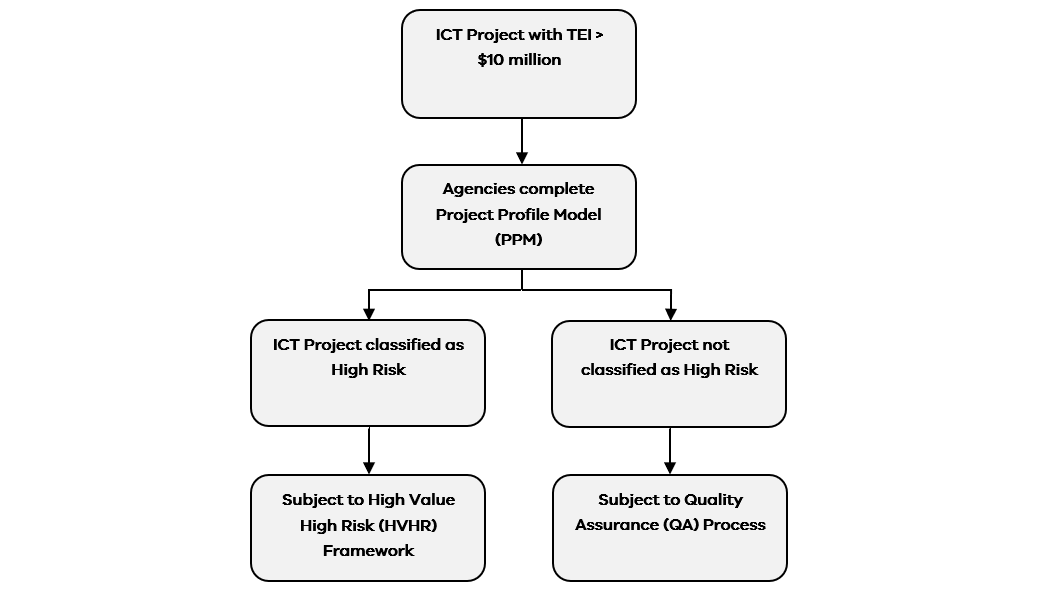About the HVHR Framework
The HVHR Framework comprises a series of project assurance checks and processes for HVHR projects to increase the likelihood that they will achieve their stated benefits and be delivered successfully, on time and to budget.
To this end, the HVHR Framework seeks to:
- verify that robust project planning and procurement processes have been followed to support quality project planning and procurement processes and documentation; and
- provide impartial and informed advice to Government on deliverability risks.
A project will be classified as being HVHR if it is a budget-funded project that is:
- considered high risk using DTF’s risk assessment tool, the Project Profile Model (PPM)
- considered medium risk using the PPM and has a TEI of between $100 million and $250 million
- considered low risk using the PPM but has a TEI over $250 million
- identified by Government as warranting the rigour applied to HVHR investments.
The Project Profile Model (PPM) is DTF's risk-based assessment tool used to determine whether a project should be subject to the HVHR project assurance framework. Further information is available on the Book a Gateway review page.
HVHR investments are subject to extra scrutiny and ongoing involvement by the Treasurer and the Department of Treasury and Finance (DTF). Each HVHR project will have its own Project Assurance Plan. These require DTF, in consultation with departments, to assess project risks at each stage and determine whether there is a case for exemption from certain project assurance functions and/or whether there are additional functions (above the standard set) that should apply. As a result, the level of DTF involvement will vary for each project.
The Project Assurance Plan template, which includes information on when DTF will participate on steering committees, is below:
Possible levels of extra scrutiny and ongoing involvement by the Treasurer and DTF are summarised in the table below.
| Stage | Action |
| Business case approval |
|
| Project tendering | Treasurer's approval of:
|
| Project implementation | Closer oversight by DTF of:
|
High Value High Risk projects and Gateway reviews
HVHR projects are also subject to compulsory Gateway reviews and active monitoring throughout the life of the project. Gateway reviews (Gates 1 through 6) are compulsory for all HVHR projects.
All individual recommendations in a Gateway report with a 'red rating' must be reported to the Treasurer outlining the risk mitigation/s. The report will be submitted to the Treasurer via DTF and must use a recommendation action plan (RAP). This is for Gates 1 to 4 only. These documents are supplied below.
As part of the changes to the HVHR Framework, departments are required to release Gate 6 benefits evaluation reports to DTF for reporting to Government.
High Value High Risk Project Assurance Framework – 2017 update and fact sheets
The 2017 update to the High Value or High Risk (HVHR) Project Assurance Framework streamlines and targets the assurance effort for HVHR capital projects.
The 2017 updates to the Framework include changes to:
- optimise the selection of projects with the highest risks or value add opportunities
- tailor the assurance process for any project based on its characteristics by establishing tailored project assurance plans for each HVHR project
- update the assurance process when preliminary business cases are not submitted as part of the budget process
- require the release of benefits realisation reports, made available to Government.
As part of the changes to the HVHR Framework, departments are required to release Gate 6 – benefits evaluation reports to DTF for reporting to Government.
The Market-led Proposals Guideline was updated in August 2021. An overview of how the HVHR framework, including the Gateway Review Process, is applied to market-led proposals can be found below:
Project Assurance Reviews
Project Assurance Reviews (PAR) aim to provide timely independent advice to the sponsoring Department and DTF on the current progress of the program. They provide an opportunity for Government to be advised of any areas of concern regarding the program’s progress and recommendations to improve program deliverability.
DTF will be responsible for developing the terms of reference for the PAR in partnership with the project teams, based on specific project issues. The terms of reference for PARs are individually composed, based upon current and approaching key decision points and identified risks. PAR reviews are organised by DTF’s gateway unit with the costs for the review borne by the initiator of the review.
The PARs are intended to provide Government advice to determine:
- the project teams has the capability, capacity, sufficiency and level of understanding to deliver the project
- the governance team has the capability, capacity and level of engagement to achieve the investment outcomes
- the agency is prepared for the complexity inherent in necessary service delivery changes
- major project risks, issues, stakeholders, contracts and urgent actions are being adequately managed
- whether the project budget and schedule, and contingency, is adequate and being managed appropriately
- whether the project is on track to deliver its forecast benefits and whether the benefits remain relevant based upon any changes in service needs, context, and constraints of scope, time or budget.
Where appropriate, the PAR may need to consider and review the adequacy of the agency’s processes including (but not limited to) management of scope, costs, schedule, benefits, risks, procurement, business change, communications, and governance.
ICT Projects
Projects involving Information and Communications Technology (ICT) contain a unique set of risks, and involve delivery approaches that are inherently different when compared with traditional asset or service delivery projects.
To enable successful delivery of ICT projects, the Government has introduced assurance mechanisms that guide the delivery of ICT projects with a total estimated investment over $10 million (regardless of the funding source).
Agencies are required to complete DTF’s risk assessment tool, the Project Profile Model (PPM), to determine whether their project is subject to the HVHR Project Assurance Framework (HVHR Framework).
High risk ICT projects, which are subject to the HVHR Framework, will be required to undertake Project Assurance Reviews to improve delivery confidence.
Other ICT projects with a TEI over $10 million, which are not subject to the HVHR Framework, are subject to the Quality Assurance (QA) Process administered by the Department of Premier and Cabinet. The QA process involves the appointment of an independent advisor to identify project issues and provide advice on managing risk. The QA role is there to monitor project delivery actively and interject with recommendations to address elements of concern.

Links
Project Profile Model
The Project Profile Model (PPM) is DTF's risk-based assessment tool used to determine whether a project should be subject to the HVHR project assurance framework. Further information is available on the Book a Gateway review page.
Project Governance Executive Program
The Project Governance Executive Program is a short course on managing ICT-enabled projects for existing or potential Project Control Board members.
Updated

